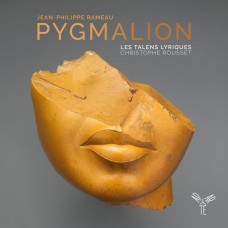|
Rameau's 'acte de ballet' 'Pygmalion', was the composer's first work to bear that designation. The term denotes a one-act
opera with the usual solo numbers, duets, and choruses, interspersed with dance episodes and is generally more
pageant-like than plot-driven! The opera was performed 30 times in 1748 and was revived to rapturous acclaim three years
later.
The story of Pygmalion dates back to Greek and Roman mythology: the sculptor of the title forswears marriage, but then falls
in love with his own perfect representation of a woman, beseeching Aphrodite (or Venus) to bring her to life. In Rameau's
hands, the story became a sunny romantic comedy and one of his best-loved works. Like Ovid's Love, Christophe Rousset
gives life to this score and leads a new and essential reading.
Pygmalion. Acte de ballet (1748)
1. Ouverture | 2. Scene 1 - Pygmalion : « Fatal Amour, cruel vainqueur »
3. Scene 2 - Pygmalion, Cephise : « Pygmalion, est-il possible que tu sois insensible »
4. Scene 3 - Pygmalion, la Statue : « Que d'appas ! Que d'attraits ! »
5. « D'ou naissent ces accords » | 6. « Quel prodige ? Quel dieu ? » | 7. « De mes maux A jamais »
8. Scene 4 - L'Amour, Pygmalion, la Statue : « Du pouvoir de l'Amour »
9. « Jeux et ris qui suivez mes traces » ariette vive et gracieuse
10. Les differents caracteres de la danse | 11. Sarabande pour la Statue
12. « Le peuple dans ces lieux s'avance »
13. Scene 5 - Pygmalion, la Statue, choeurs : air gay pour l'entree du peuple qui vient admirer la Statue
14. Gavottes | 15. « L'Amour triomphe » | 16. Pantomime niaise et un peu lente
17. Pantomime tres vive | 18. « Regne, Amour » | 19. Air gracieux | 20. Contredanse
21-30 Les Fêtes de Polymnie. Suite d'orchestre (1745) |
|



